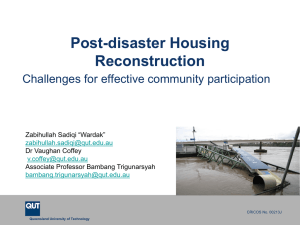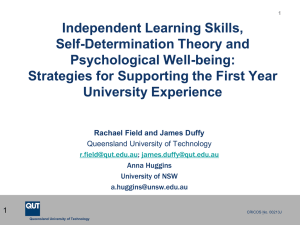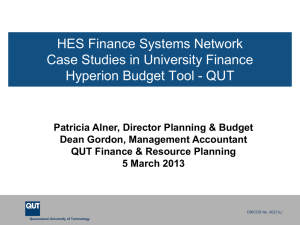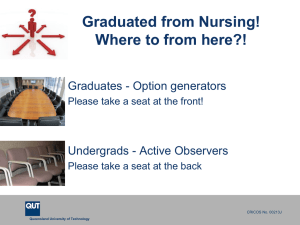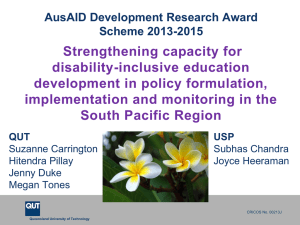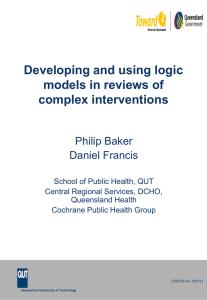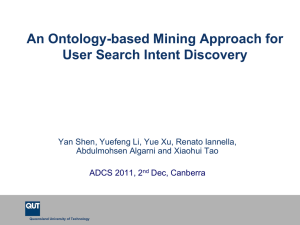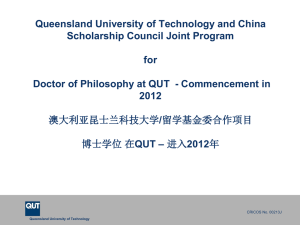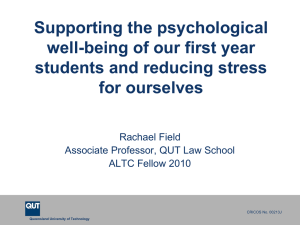real - QUT ePrints
advertisement
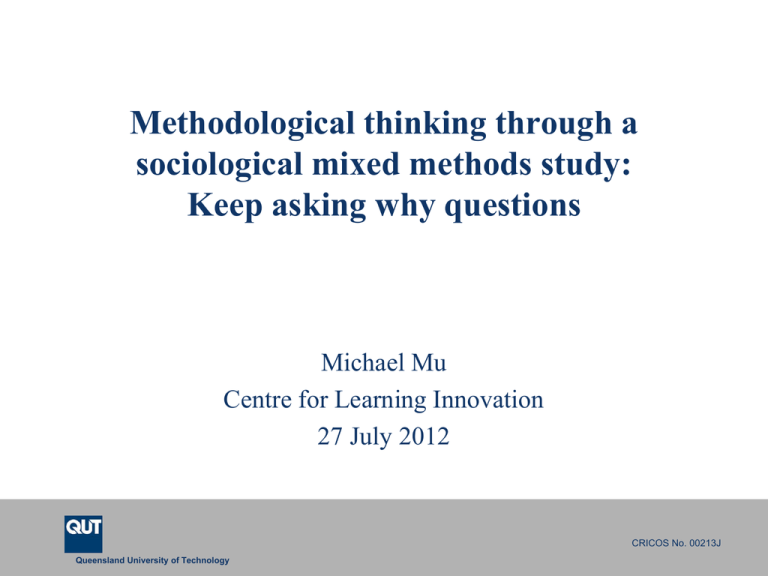
Methodological thinking through a sociological mixed methods study: Keep asking why questions Michael Mu Centre for Learning Innovation 27 July 2012 CRICOS No. 00213J Queensland University of Technology Outline 报告提纲 • • • • • • • • Research questions 研究问题 Theoretical framework 理论框架 Critical realism 批判现实主义社会学范式 Quantitative study: Survey 量化研究 Qualitative study: Interview 质性研究 Results 研究结果 Do “Quant” and “Qual” talk to each other? 量化-质性相呼应 Summary 总结 a university for the real world R CRICOS No. 00213J Research questions: 研究问题 RQ1. Is Chinese Heritage Language proficiency of young Chinese Australian adults in urban Australia positively influenced by their access to various resources, the strength of their “Chineseness”, or both? RQ2. What does Chinese Heritage Language mean to young Chinese Australian adults in urban Australia? Behind research questions…研究问题背后 • Where do these questions come from?研究问题从何衍生? • Why Chinese Heritage Language?为何研究汉语继承语言? • Why Australia?为何选择澳大利亚情境做研究? • Why Chinese Australians?为何研究澳大利亚华裔? • Why young urban adults?为何研究城市年轻人? • What are the methodological implications of these questions? 研究问题对研究方法有何启示? a university for the real world R CRICOS No. 00213J Literature review文献综述 Social psychological perspective Motivation Ethnic identity Bourdieusian perspective Recast Capital Habitus Reconcile Complement Investment a university for the Poststructuralist perspective real world Ethnic identity R CRICOS No. 00213J Theoretical framework理论框架 “[(habitus) (capital)] + field = practice” (Bourdieu,1989, p.101) “[(惯习)(资本)]+场域=社会实践”(布迪厄,1989, p.101) People make language choices as a form of their social practice according to the positions (capital) and dispositions (habitus) they have within a given field (Bourdieu, 1991). Language choices may generate products that respond to the demands of a given field (Bourdieu, 1991). Four forms of capital CHL proficiency as linguistic capital Chineseness as habitus Fields Conceptual framework概念框架 a university for the real world R CRICOS No. 00213J Why critical realism?为何选择批判现实主义 • • Realist ontology and constructivist epistemology (Bhaskar, 2008) 现实主义本体论和建构主义认识论 Critical realist ontological map批判现实主义本体论认知图 Reality at three different levels (empirical, actual, and real) 事实的三个层面(经验层面、现实层面、真实层面) • • Theoretical links to Bourdieu 批判现实主义与布迪厄社会学理论的联系 Agency & structure 能动性与结构 Habitus, capital, & field 惯习、资本、场域 Methodological links to Bourdieu 批判现实主义与布迪厄研究方法的联系 Tolerance of the combination of intensive and extensive research procedures 深度研究与泛式研究相结合 “to grasp the particularity within the generality and the generality within the particularity” (Bourdieu & Wacquant, 1992, p. 75) “statistics are bound to be abstract” and with the complement of interviews and texts, profound phenomenon can be revealed “even more clearly” (Bourdieu, 1996, p. 174) a university for the real world R CRICOS No. 00213J G=mg What we experience and observe at the empirical level 经验层面的观察和体会 What is happening independent of our observation at the actual level 现实层面的正在发生 What is the mechanism at the real level 真实层面的推动机制 Empirical data in our research 研究数据 Actual problems in our social world 现实世界 Real laws, rules, and theories 真实定律 a university for the real world R CRICOS No. 00213J Fallible empirical assumptions 对事实的错误认识 Son: I can’t see any whale. 儿子:我看不到鲸鱼! Dad: There is no whale today. 父亲:今天没有鲸鱼。 Temperature and salinity of the sea water are the major driving forces for whale migration. 海水的温度和盐度是鲸鱼迁徙 的主要原因。 a university for the real world R CRICOS No. 00213J The initial quantitative study: Survey 量化研究:调研法 • • • • • • RQ1 and hypotheses研究问题和建立假说 Conceptual framework概念框架 Statistical modeling: Structural Equation Modeling结构方程模型 Instrument design (What) 研究工具设计 Target population (Who) 取样对象 Sample size and sampling (How many and how) 样本量和取样方法 • Ethics number: 1100000165 (Clearance until 10/02/2014)研究伦理 • Instrument development: Reliability and validity 研究工具改进:性效度 a university for the real world R CRICOS No. 00213J Research question and null hypotheses: 研究问题和虚无假说 RQ1. Is CHL proficiency of young Chinese Australian adults in urban Australia positively influenced by their investment of capital, the strength of their habitus of “Chineseness”, or both? H01. The habitus of “Chineseness” of young Chinese Australian adults in urban Australia has no statistically significant positive impact on their CHL proficiency. H02. The investment of capital of young Chinese Australian adults in urban Australia has no statistically significant positive impact on their CHL proficiency. Methodological thinking behind hypothesizing: Why null hypotheses H0 instead of alternative hypotheses H1? 为什么建立虚无假说而不是对立假说? a university for the real world R CRICOS No. 00213J Conceptual framework that drives the examination of RQ1 and hypotheses testing 支撑研究问题一以及假说验证的概念框架 Four forms of capital CHL proficiency as linguistic capital Chineseness as habitus Fields a university for the real world R CRICOS No. 00213J Why Structural Equation Modeling?为何选择结构方程模型? • SEM is theory driven. 理论驱动 • SEM has the capability to assess reliability and validity.性效度检验 • SEM improves statistical estimation by accounting for unique disturbances in the estimation process.减少测量误差 Statistical assumptions: • Interval level of measurement • Multivariate normal distribution Chineseness = v9 × .18 + v7 × .21 + v4 × .21 + v3 × .16 + v2 × .23 a university for the real world R CRICOS No. 00213J Methodological thinking behind instrument design: • Operationalization: From theoretical concepts to measurable variables 操作化:从理论概念迁移到可测量变量 • Reflective model vs formative model:反映式与形成式模型 Existence of latent variable潜变量的存在方式 Direction of causality因果关系的方向 Intercorrelations between indicators显变量的交互相关性 • What is the level of measurement? – Nominal, ordinal, interval, and ratio 变量的测量水平:类别变量,等级变量,等距变量,等比变量 Why a 7-point Likert-type uni-polar scale? 为何采用里克特七点单向量表? • Why online questionnaire?为何采用网络问卷? a university for the real world R CRICOS No. 00213J Population and target population:研究对象与取样对象 • Population: young Chinese Australian adults in urban Australia • Target population: young Chinese Australian adults in urban Australia Range in age between 18 and 35 Have had moved to Australia before the age of 13 if born outside Australia Methodological thinking behind population framing: • Why between 18 and 35?为何选择18-35岁? 17-33 (Levinson, 1978) • Why before 13?为何选择13岁? (Bhatti, 2002; Zhang, 2009) • Why the Australian-born and the non-Australian-born can be included in the same population frame? 为何澳洲出生与非澳洲出生的华裔可以在同一人群框架下研究? (Cho, 2000; Cho, Cho, & Tse, 1997; Zhang, 2009) a university for the real world R CRICOS No. 00213J Sample size:样本量 • • • • • Different statistical models have different rules-of-thumb to identity the optimal sample size. There is a mathematical relationship amongst sample size, effect size, significance level, and power value. e.g. in regression, N ≥ L / f2, where f2 = R2 / (1 - R2) and L = 6.4 + 1. 65 × k - .05 × k2 (Green, 1991) significance level .05 / power value .80 (Cohen, 1992) effect size .02, .15, .35 (Cohen, 1988) G-Power software SEM in general requires a larger sample size. Unfortunately, there is a lack of agreement on the exact meaning of “a larger sample size”. It is recommended that the sample size be no less than 200 in order to provide reliable results (Bentler & Chou, 1987). a university for the real world R CRICOS No. 00213J Why snowball sampling?为何采用滚雪球取样法? • Possibility sampling (e.g. simple random sampling, systematic random sampling, stratified sampling, or cluster sampling) is practically impossible for the current research. • Snowball sampling is commonly done when the participants are rare and thus difficult to access or identify (Nardi, 2006), for example, in heritage research (Gibbs & Hines, 1992; Hall, 1992; Kiang, 2008; Pao, Wong, & TeubenRowe, 1997; Root, 1992). a university for the real world R CRICOS No. 00213J Population a university for the Target population real world Sample R CRICOS No. 00213J Instrument development:研究工具改进 • Pilot study: Internal consistency reliability and face validity 初测:内部一致性信度和表面效度 • Measurement models: Reliability and validity 测量模型的信效度 Four measures of reliability四项信度指标 SMC: Cutoff .50 (Jöreskog & Sörbom, 1996) Construct reliability: Cutoff .50 (Fornell & Larcker, 1981) Variance extracted: Cutoff 50% (Fornell & Larcker, 1981) Coefficient H: Cutoff .70 (Hancock & Mueller, 2001) Two measures of validity两项效度指标 Construct validity: Unidimensionality (model fit) Convergent validity: Significant critical ratio a university for the real world R CRICOS No. 00213J The subsequent qualitative study: Interview 质性研究:访谈法 • • • • Research question: 研究问题 RQ2. What does CHL mean to young Chinese Australian adults in urban Australia? Why phenomenology? 为何采用现象学研究思想? Thematizing: Conceptual framework that informs the broad topics to be investigated 主题化:由概念框架延伸出访谈主题 Designing 研究设计 One-to-one semi-structured multiple interviews (Bourdieu, 1999) 一对一、半结构式、多次访谈 Face-to-face, by telephone, or online 面对面、电话访谈、在线访谈 Sample size: 1 to 10 for phenomenological studies (Starks & Trinidad, 2007) 现象研究中的被访人数:1-10 Purposeful sampling: Extreme sampling and maximum-variation sampling (Patton, 1990) • 目的性取样:特殊案例取样和最大变化取样 Interviewing 访谈过程 a university for the real world R CRICOS No. 00213J Conceptual framework that informs the formulation of questions to be asked Four forms of capital CHL proficiency as linguistic capital Chineseness as habitus Fields Languages always produce the products that respond to the demands of a given field (Bourdieu, 1991). • What are the products produced by Chinese Heritage Language learning? • Does Chinese Heritage Language practice produce any valued asset? • Are these assets ‘capital’ or ‘habitus’? a university for the real world R CRICOS No. 00213J Methodological thinking behind interviewing: • Power relations (Bourdieu, 1999) 权利关系 (布迪厄,1999) • Researcher’s subjectivity: Why I am entitled to conduct this interview? 研究者的主体性:为什么我可以做这个访谈? • Benefits: Reliability and validity 改善性效度 The interviewees seemed to consider this situation as an exceptional opportunity to “make themselves heard” and to “carry their experience over from the private to the public sphere” (Bourdieu, 1999, p.615). Their speech seemed to convey “a joy of expression” (Bourdieu, 1999, p.615). a university for the real world R CRICOS No. 00213J Power relations (Bourdieu, 1999) Asymmetry of symbolic power and unequal distribution of capital, “cultural capital in particular” (p. 609) “Active and methodical listening” (p. 609) Verbal “signs of feedback” or “response tokens” (p. 610), such as “yes”, “right”, “oh”, and “ok”, as well as aiding explanations in a proposed rather than an imposed way, such as suggestions to offer multiple and open-ended continuations to the participants’ hesitations or searchings for appropriate expressions (pp. 614-615) Non-verbal means, such as an open posture, approving nods, appropriate facial expressions, and good eye contact a university for the real world R CRICOS No. 00213J Why I am entitled to do this research? Two problematic extremes (Bourdieu, 1999) “Total divergence” (p. 612), where understanding and trust are not possible “Total overlap” (p. 612), where nothing can be said and questioned because everything goes without saying “Proximity and familiarity” between the researcher and the researched (p. 610) Social difference between the researcher and the researched a university for the real world R CRICOS No. 00213J The subsequent qualitative study: Interview 质性研究:访谈法 • • Transcribing 转录过程 Reliability: Member check and participant check Validity: Reconciliation of “fidelity” and “readability” (Bourdieu, 1999, p.622) “The transition from the oral to the written, with the changes in medium, imposes infidelities which are without doubt the condition of a true fidelity.” (Bourdieu, 1999, p.622) Data analysis 数据分析 An ongoing and recursive process within phenomenological traditions (Mertens, 2005) 现象学研究中递进回归的数据分析过程 • General sense – Meaning condensation – Coding – Categorizing – Themes 了解大意 – 精炼主旨 – 编码 – 分类 – 主题 Reporting: Whose accounts in which context? 数据汇报:特定情境下的特定记述 a university for the real world R CRICOS No. 00213J a university for the real world R CRICOS No. 00213J Quantitative data analysis and findings RQ1. Is Chinese Heritage Language proficiency of young Chinese Australian adults in urban Australia positively influenced by their investment of capital, the strength of their habitus of “Chineseness”, or both? H01. “Chineseness” of young Chinese Australian adults in urban Australia has no statistically significant positive impact on their Chinese Heritage Language proficiency. a university for the real world R CRICOS No. 00213J Quantitative data analysis and findings RQ1. Is Chinese Heritage Language proficiency of young Chinese Australian adults in urban Australia positively influenced by their investment of capital, the strength of their habitus of “Chineseness”, or both? H02. The investment of capital of young Chinese Australian adults in urban Australia has no statistically significant positive impact on their Chinese Heritage Language proficiency. a university for the real world R CRICOS No. 00213J Qualitative data analysis and findings RQ2. What does Chinese Heritage Language mean to young Chinese Australian adults in urban Australia? Theoretical Concepts Economic capital Benefits of CHL/ Meanings of CHL Job opportunities Chinese cultural goods Understanding of Chinese culture Chinese way of doing things Cultural capital Formal education credits Social capital Symbolic capital Habitus Field Communication with family members Communication with friends Socialisation with people Recognition by people Awards Coding criteria Adam Bob Crystal Dianna En-ning Convertible into money Objectified cultural capital: Material forms of cultural goods Embodied cultural capital: Lasting dispositions of mind and body, existing in the form of schemata of perceptions and actions Institutionalised cultural capital: Cultural competence with a conventional, constant, legally guaranteed value in connection to certain institutions Contacts and group memberships that provide actual or potential support and access to valued resources Reputations for competence and images of respectability and honourability √ √ √ √ √ √ √ Embodied dispositions Family roots Unconscious dispositions Conscious actions Immanent propensities linked to cultural history that drive the actions both intentionally and unintentionally Different values in different situations A social place containing agents struggling for positions by the control of resources a university for the real world √ √ √ √ √ √ √ √ √ √ √ √ √ √ √ √ √ √ √ √ √ √ √ √ √ √ √ √ √ √ √ √ √ √ √ √ √ √ √ √ √ √ √ √ √ √ √ √ R CRICOS No. 00213J Do “Quant” and “Qual” talk to each other? 量化-质性相结合 • “Quant” and “Qual” research questions Connection rather than separation 研究问题层面:相互关联而不相互分离 • “Quant” and “Qual” research methods Combination rather than opposition 研究方法层面:相互结合而不相互排斥 • “Quant” and “Qual” research findings Extension and confirmation rather than objection 研究发现层面:相互补充和确认而不相互对立 a university for the real world R CRICOS No. 00213J Methodological map of this sociological mixed methods study Paradigm / Worldview: Critical realism Theoretical lens: Bourdieusian stance Research questions Methodological approach: Mixed methods research Bourdieu’s theories Research methods: Survey and interview Research design: instrument, sample, analysis a university for the real world R CRICOS No. 00213J a university for the real world R CRICOS No. 00213J
